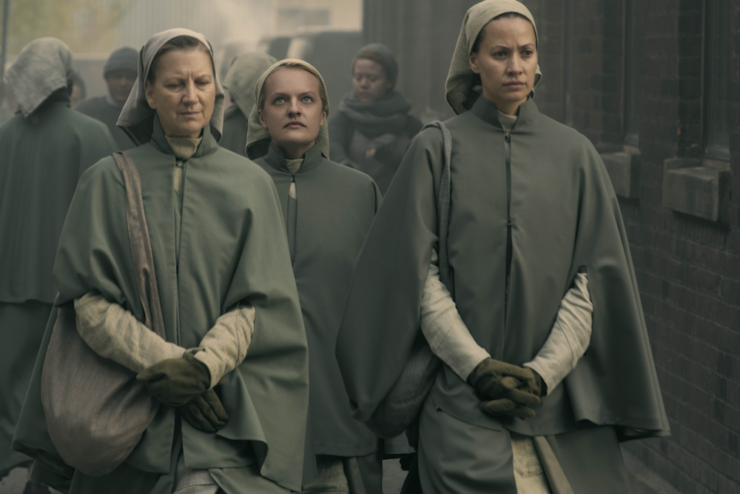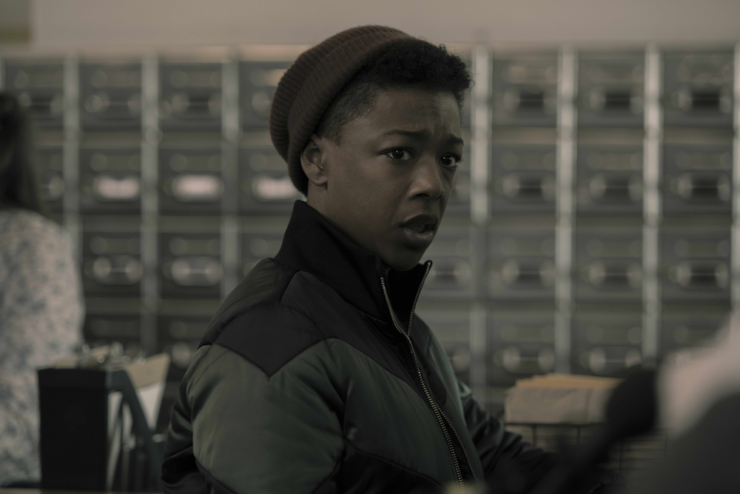The Handmaid’s Tale certainly delights in its own striking visuals. Hulu’s dystopian series kicks off season 3 with the Waterfords’ home on fire—the bedroom, site of Ceremonial rapes; the kitchen, full of quiet rebellions; the empty nursery, all going up in flames. It seems to say we’re going to burn this shit down, borrowing a refrain from protests (in person and on social media) by those who have had enough. Or, a few episodes later, there’s the admittedly badass shot of Serena Joy (Yvonne Strahovski) and June (Elisabeth Moss) coolly lighting up cigarettes side-by-side in a room, co-conspirators and, briefly, equals.
But in terms of actual destruction or change, it’s all just smoke. Last season, June turned her back on her chance of escape, handing baby Nichole to Emily (Alexis Bledel) to ferry to Canada and walking back into Gilead to rescue her other daughter, Hannah. And, presumably, burn it all down. But halfway through the third season, Gilead is far from revolution. A few revs, but not nearly enough to shatter the status quo.
A non-spoiler review of The Handmaid’s Tale season 3.
The first six episodes screened for critics are best watched in quick succession, as they create a clear (if slow) narrative of small cracks in Gilead’s foundation as its women begin to connect across hierarchical structures. But as Hulu releases its episodes weekly, the pace may feel ponderous to viewers. The two-steps-forward-three-steps-back storytelling can seem too halting to demand viewers return, week after week, to a Gilead that barely shows signs of changing.

But the signs are there. Consider the first season, when there was no breaking of ranks between Wives and Marthas, Marthas and Handmaids, Handmaids and Aunts. When women’s language was so policed, their thoughts so gaslit, that if they said anything beyond the refrain of “blessed be the fruit”/“may the Lord open” they would likely be beaten for it. From Handmaids joking amongst themselves about brunch, to June imploring Serena to consider a better life outside of Gilead for their infant daughter, the women of Gilead have begun speaking more directly to one another.
Season 3 builds upon these tenuous connections in a number of highly emotional scenes between women who share custody of children through blood and upbringing, and who acknowledge the Handmaids as mothers. June shares a moment with Hannah’s adoptive mother about her allergies to dogs; Serena and June talk more about Nichole than the Wife does with Commander Waterford (Joseph Fiennes). Have no doubt, these scenes are revolutionary; the more Wives who see Handmaids as people and not just vessels, the more of a groundswell there will be.

Unfortunately, if the Wives are the only ones fighting to change Gilead, then change will be a long way off. There are some subplots in the early episodes that make it seem as if June—who has already played a Jezebel and masqueraded as an Econowife—might infiltrate another tier of Gileadean society, but that plot thread is discarded in favor of having June remain a Handmaid. Interestingly, she is installed in the home of Joseph Lawrence (Bradley Whitford), eccentric architect of Gilead who can be persuaded to subvert his own system—but only if his selective morality deems the risk worthy enough to justify the treason.

Despite June being the series’ protagonist, she does not rank high on Commander Lawrence’s list. In fact, she occupies a curious space between his household—which, you’ll remember, does not stand on Ceremony—and the Waterfords’, as her prior Commander and Wife demand her presence for increasingly public-facing negotiations with Canada about Nichole. “I’m sorry, baby girl,” June says in voiceover to Nichole when she turns her back on her. “Mom’s got work.” That work is mostly emotional labor, as she tries to mend the Waterfords’ relationship while continuing to work on Serena, who is faced with increasingly compelling temptations to reject Gilead yet remains an aggravating example of a complacent white woman too scared to lose her relatively elevated place in society.

Considering June’s frustrating lack of momentum, the series smartly expands its viewpoint beyond her own scrabbles at survival, both by revisiting supporting players in stirring character portraits and by examining big-picture interactions between Gilead and other countries.
In the first few episodes we see more of Canada than we did all last season, as Emily seeks asylum—and absolution, and normality, and a balm for the helpless rage that still surges within her. Even if Gilead itself seems in danger of remaining stable, it is vital to follow the people who escaped its grip. On her way to reunite with her own family, the former Handmaid passes Nichole on to Luke (O.T. Fagbenle) and Moira (Samira Wiley), who have already become a family in June’s absence but who must reform their shaky dynamic around a new, vulnerable member. And just when you thought the series had gleaned every last detail from its source material, the writers pull out a fabulous new Easter egg that will make readers of Margaret Atwood’s book choke up and cling to a small hope.

Luke especially will play a key role in a season that is becoming increasingly about international relations, and the responsibility of external governments to intervene. In many ways, Gilead makes a fearsome enemy; but it is a very young nation still waging internal war. It’s a shame, however, that the distant battles in Chicago get more acknowledgment than a Handmaid’s resistance bombing last season.
Change in Gilead is slow going, not unlike in our present. But what’s the point of aspirational fiction if not to make the strides that don’t feel plausible in the real world? By the end of episode 6, there are more cracks in Gilead’s foundation than there were in episode 1. Here’s hoping the latter half of the season finally smashes through.

Scraps
- All the time spent in Canada makes me want to see how things are going in Mexico. Though considering how amenable the Mexican ambassador seemed to importing Handmaids back in season 1, things probably are only getting bleaker.
- The music cues, usually so spot-on, were very hit-or-miss for me. “I Don’t Like Mondays” was used in a scene that only really makes sense if you squint; especially now, anything with a reference to mass shooting is difficult to recontextualize. But later uses of “You Make Me Feel Like Dancing” and “Cruel to Be Kind” work beautifully.
- The series’ costume designs (by Natalie Bronfman in season 3) continue to fascinate and often horrify, from a new accessory for Serena Joy to a shudder-inducing addition to the Handmaid ensemble.
- The recurring shots of June’s face, shot from below, made ugly with hatred, are increasingly disturbing. Which, to be clear, is a good thing! But their repetition in this season start to lessen their impact; does seeing the Handmaid making herself look like what the Commander would call “unfeminine” with her naked rage at the system, actually do anything to change it?
Natalie Zutter definitely appreciated the analog throwback to the book. Talk The Handmaid’s Tale season 3 with her on Twitter!










